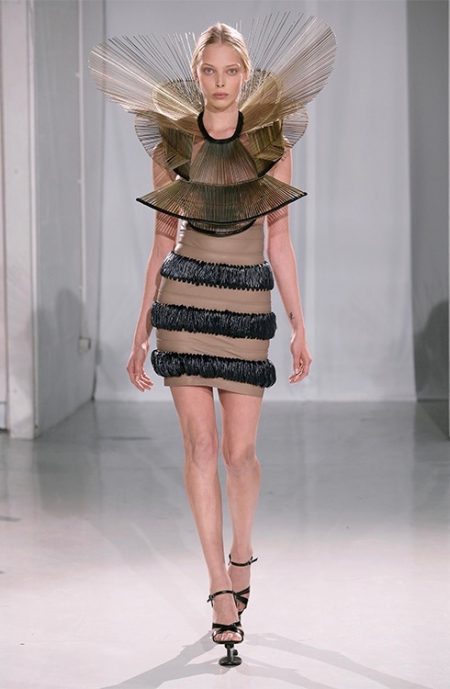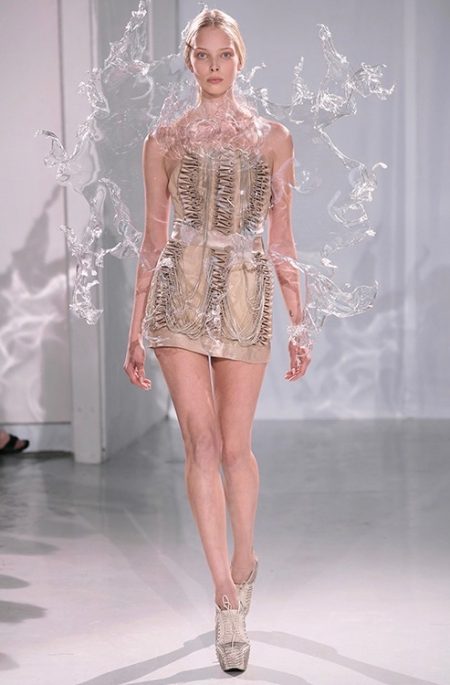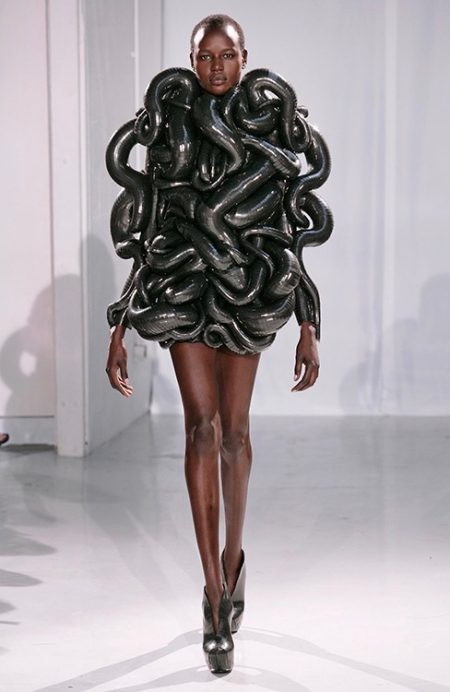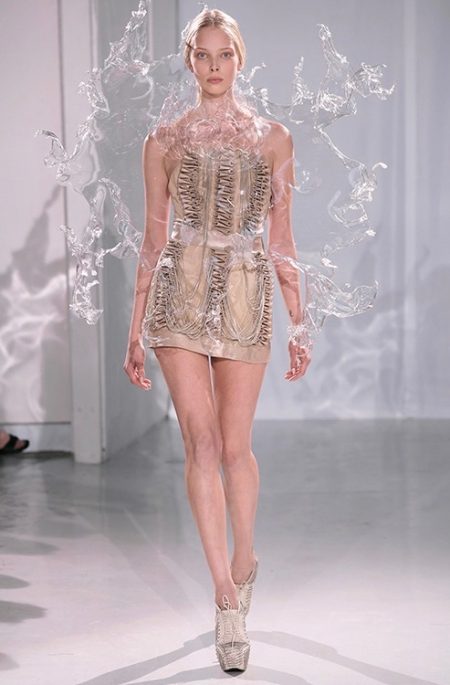The title of the Cincinnati Art Museum’s new exhibition showcasing the work of Dutch fashion designer Iris Van Herpen is very aptly named Transforming Fashion. Van Herpen’s creations have changed the face of fashion design while redefining what it means to be a fashion designer in the 21st century. The exhibit itself has left this author transformed.
Transformed into someone who can now only see clothing as living, breathing works of art. They are not simply wares to adorn the body. They can be so much more and, when in the right hands, they are. With a mind like Van Herpen’s at the helm, fabrics and other design materials are crafted into an amalgam of beauty and purpose.

As you walk down the strikingly stark corridors of the upstairs CAM gallery, it’s noticeable right away that the descriptions of each piece are smartly left on the walls tucked within an in-depth look at the inspiration behind each collection. It’s a small thing, but a welcome one as having descriptive text about each garment next to them can be quite distracting. And you don’t want to be distracted here.
After getting a good look at where Van Herpen’s mind was during the collection’s design process, you walk a few steps to see three seminal pieces from the line. On their own, without distraction, all you want to do is stare at every fold, every stitch, every innovative use of interesting material.
In her debut collection, Chemical Crows, the artist was inspired by the crows that had made a home outside of her studio. Where one designer may have gone the traditional route of crafting garments out of feathers, she used umbrella ribs and industrial yarn to design garments reminiscent of gilded crows. The internal ribs of the umbrella, now colored in a golden hue, were shaped into fan-like structures described by the exhibition as whimsical. When seen on the body it was reminiscent of a corset highlighting the skeletal structure of the wearer, a motif also seen in a different way in the Charles James’ exhibit several years ago and later in her work when it manifested itself as a “skeleton dress” in the Capriole collection.
The industrial yarn was layered to portray the look of wings in motion without using the obvious feather as accent. While only her first collection, Chemical Crows showed the artist’s penchant for using unusual materials to create an effect. Yes, she could have used feathers. But it was much more interesting that she didn’t.
Along the way, you’ll notice how each collection influences the next in small ways with some design elements that carry over. Mostly though, you’ll see the designer growing stronger in her imagination of the impossible. She grows bolder in creating more textiles from scratch, using technology and good old hand craftsmanship to bring her ideas to life.

Several videos highlight Van Herpen in different ways throughout the showcase (all in separate rooms so as to not distract from the pieces themselves). There is a video showcasing her process, where one is reminded first and foremost that Van Herpen is incredibly young for how amazing her work is. You also learn that her upbringing was very traditional and she went to fashion school similar to most fashion designers working today. Somehow, though, Van Herpen’s aethetic was crafted to be far beyond those of her counterparts.
You also get a glimpse into the artist herself, seeing her at work in her atelier in Amsterdam. Two interesting highlights: (1) While she shows in Paris at Couture Fashion Week to great fanfare, it is in her Atelier that she feels most at home. The process is more important to her than the end result. And (2) although known for her use of technology, 3-D printing especially, Van Herpen sees these methods as merely the tools. Technology is not her inspiration, she says, and, at this point, she can make everything by hand that is 3-D printed and vice versa. Sometimes crafting a piece by hand is the best way to create a garment, highlighted by the designer’s first attempt at a piece that looked like water cascading around the body in her Crystallization collection. That garment came to life thanks to a sheet of transparent polyethylene terephthalate (PET), a hot glue gun, a pair of pliers and the very capable hands of Van Herpen. Slowly and methodically, the designer heated the PET and manipulated it using the pliers and her hands so the finished product looked like molded plastic suited to the body.
The designer said in the video that she tried creating the initial garment using printing, but the effect was simply better when done by hand. One of the other videos in the exhibit showed this technique in detail as she handcrafted a dress using those same materials to simulate water in motion (specifically in the video water being thrown on Daphne Guinness).
The most intriguing part of the exhibit, what makes it stand out as not merely just a row of meticulously crafted garments on display was the exhibit’s Please Touch section. As visitors walk through the hall of looks, it takes every fiber of self- control to not touch the garments. They are so incredibly intricate, often made from materials and fabrics never before crafted, that Please Do Not Touch notices on every surface was the only thing stopping this author from touching the piece just to see what it felt like.
Thankfully Cynthia Amnéus, Chief Curator and Curator of Fashion Arts and Textiles, seemingly thought of this possibility ahead of time and put a section in place where some of textiles invented by Van Herpen were on display to touch. To be honest, it made this author want to go back and re-examine every corresponding piece made of the materials shown. It made the experience more real and made Van Herpen’s genius shine even brighter.
One of the materials highlighted in the Please Touch area was the transparent photopolymer and stereolithography resin that Van Herpen’s 3-D printed dress was made from for the Magnetic Motion collection. Noted as one of her most important achievements by the designer herself, this dress was a triumph. At the time, the 3-D printing company she was working with told her that it was impossible to 3-D print a transparent dress. With the material she had in mind, transparency was simply impossible. However, Van Herpen insisted and worked closely with the printer to the point that in two weeks’ time, the dress was made. The designer has worked closely with different collaborators over her tenure, from architects to artists to printing houses, to ensure her vision comes to life. This dress is an example both her collaboration skills and her insistence that her ideas can be made real despite what was done before.
Being able to touch and feel the plastic-life resin made the garment much more rooted in reality. It was thick, but not too heavy in that it wouldn’t be possible in dress form. The grooves embedded in the resin also showed well Van Herpen’s intricate handwork and ability to manipulate materials in line with the inspiration behind Magnetic Motion.
Overall, it must be admitted that expectations were very high for this exhibition. Given Van Herpen’s immense talent and Amnéus’ known admiration for her work, Transforming Fashion has been in the works for a long time. It does not disappoint and, in fact, is even better than imagined.
Go there now, the exhibition will be on display until January 7, 2018.
–Jennifer Perusek
Images Courtesy of The Cincinnati Art Museum. Credits:
Iris van Herpen (b. 1984), The Netherlands, Biopiracy, Dress, March 2014, 3-D printed thermoplastic polyurethane 92A-1 with silicon coating, in collaboration with Julia Koerner and Materialise, Collection of Phoenix Museum of Art, Gift of Arizona Costume Institute. Photo by Bart Oomes, No 6 Studios
Iris van Herpen (b. 1984), The Netherlands, Capriole, Ensemble, July 2011, 3-D printed polyamide, in collaboration with Isaie Bloch and Materialise, Groninger Museum, 2012.0209. Photo by Bart Oomes, No 6 Studios
Iris van Herpen (b. 1984), The Netherlands, Voltage, Dress, January 2013, laser-cut 3-D polyester film lace and microfiber, in collaboration with Philip Beesley, Groninger Museum, 2017.0008, Photo by Bart Oomes, No 6 Studios
Iris van Herpen (b. 1984), The Netherlands, Radiation Invasion, Dress, September 2009, faux leather, gold foil, cotton and tulle, Groninger Museum, 2012.0201. Photo by Bart Oomes, No 6 Studios
Iris van Herpen (b. 1984), The Netherlands, Magnetic Motion, Dress, September 2014, 3-D printed transparent photopolymer and stereolithography resin, High Museum of Art, Purchase with funds from the Decorative Arts Acquisition Trust and through prior acquisitions, 2015.82. Photo by Bart Oomes, No 6 Studios


